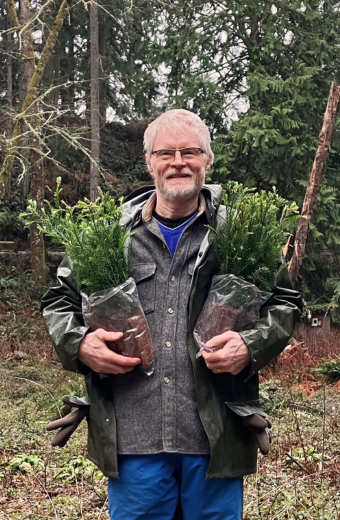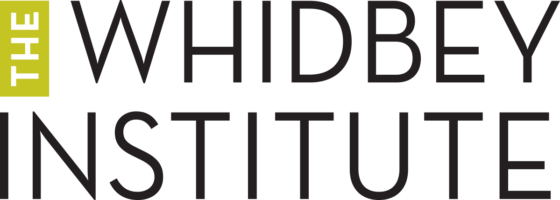 I recently had a chance to sit down with Larry Rohan, the Whidbey Institute’s new Forest Steward. Larry embodies a deep-rooted passion for the natural world, cultivated over a lifetime of exploration and study. With a BS in Forestry from Purdue University and experience with the US Forest Service and Alaska native tribes, Larry brings a wealth of knowledge to this new role at the Whidbey Institute. His work is driven by a profound understanding of the interconnectedness between forests, soil, and climate and his dedication to conservation and environmental stewardship is not only a testament to his commitment to creating a better world for future generations.
I recently had a chance to sit down with Larry Rohan, the Whidbey Institute’s new Forest Steward. Larry embodies a deep-rooted passion for the natural world, cultivated over a lifetime of exploration and study. With a BS in Forestry from Purdue University and experience with the US Forest Service and Alaska native tribes, Larry brings a wealth of knowledge to this new role at the Whidbey Institute. His work is driven by a profound understanding of the interconnectedness between forests, soil, and climate and his dedication to conservation and environmental stewardship is not only a testament to his commitment to creating a better world for future generations.
Please describe your role at the Whidbey Institute.
I am the Forest Steward at the Whidbey Institute. As far as I know, this is a new role for the organization. In the past, people have taken up bits and pieces of what I’m doing, but to my knowledge, this is the first time that the forest steward role exists.
A big part of my job is looking after the 106 acres of land, including the building envelopes, which contain the structures of the Institute and the Whidbey Island Waldorf School. Most of the forest land here is in a conservation easement managed by the Whidbey-Camano Land Trust (WCLT). The conservation easement contains specific rules as to what is allowed and what’s not allowed in the forest. Their role is to protect and enhance the conservation values of the forest, wetlands, and the diversity of native plants and wildlife.
There are approximately 4+ miles of trails in the forest to look after as well, and the conservation easement contains rules about trail use and overall length. For instance, the Whidbey Institute cannot add trails, at least not without approval from the Land Trust. If we want to add trail length in one area, we would have to decommission an equal amount somewhere else.
I am also responsible for implementing the Forest Stewardship Plan, which lays out both short and long term strategies to address forest health. Some of the immediate challenges in the forest are pockets of root rot, various invasive plant species, and hazard trees threatening structures. All forest activities must be in compliance with the conservation easement. The WCLT is aware of this work and has approved our Forest Stewardship Plan
There are strong restrictions on what happens in the forest as far as cutting and harvesting of trees. We cannot harvest trees for monetary gain. We can, however, harvest for other reasons, such as the health of the forest. A thinning that would benefit overall health and diversity would be allowed. If there are hazardous trees threatening one of the buildings or trails, we can harvest those or cut them back. There are also some restrictions on whether we can take that material out of the forest or leave it on the ground.
So it sounds like the conservation easement is a bit of a guidepost for you. Do you work with that document pretty closely in terms of outlining your work and what you need to do? Or if you had to weigh one side or the other, is it the conservation easement or is it the forest?
The forest itself is a crucial guide for my work, and I just have to go back and check the conservation easements to make sure that everything I am doing is in compliance with it.
The Forest Stewardship plan, which has a lot of information in it, is probably more my template. I am looking at that and deciding what the priorities are and how I implement them. Sometimes it just means giving the WCLT notice.
I’m really trying to let nature lead while I follow. All management decisions will be done in a cautious way, while observing how the forest responds over time to any practices that we might implement.
If we’re going to cut trees, for instance, anywhere up to 100 feet away from any structure and up to 30 feet away from any trail is approved, but the Land Trust needs to be notified that that’s going to happen.
One of the most important parts of being the Forest Steward here, as I see it, is the safety of the humans and buildings that are on the property. There are a number of trees that are threatening some buildings. So that will be the first thing to take care of.
But as far as stewarding a forest, it’s not an exact science. I’m really trying to let nature lead while I follow. All management decisions will be done in a cautious way, while observing how the forest responds over time to any practices that we might implement.
Let’s go back a little bit further, before your arrival to the Whidbey Institute. Where are you originally from?
I grew up in Chicago. I started loving the forest at an early age, when I got to go out and be a Boy Scout, when I got out of the city and went to the woods and had those experiences. I ended up studying forestry at Purdue University and had my first seasonal job on the Olympic National Forest when I was a junior in college.
That’s what got me out to the Northwest and I just fell in love with the mountains and forests here. After graduation, I made my way back to the Olympic Peninsula where I worked as a silviculturist for the Forest Service. I also worked for private landowners, mostly cruising timber in Oregon, Idaho, Washington, and Southeast Alaska. Things are really different now, but back then it was pretty much taken for granted that practices such as clear cutting and slash and burn were the primary ways that forests were managed.
In 1991, I moved to Whidbey Island, bought ten acres of land that’s about a half mile away from the Whidbey Institute, and discovered this place by wandering up the creek that runs through my property and whose headwaters are right here at the Whidbey Institute. It didn’t take me long to begin to love the trail system here. Being a trail runner, I made it a point to come here often. That’s how I learned about the institute.
Between that time and becoming the Forest Steward here, I made a living by operating a cabinetry business from home. This allowed me to stay on the island, raise a family, and make it to the soccer games and theater productions that the kids were active with.
I have heard of a “grandmother tree” on the land, an old growth cedar growing somewhere. Do you know where it is in the forest?
There’s one old growth tree that I know of. It has fire scars and deeply furrowed bark typical of very old trees. I would guess its age to be over 300 years and its location is near the South Junction. I believe the reason it’s still standing is that it has a huge scar on one side of it. It was a forked tree and at one point that other stem broke off, which probably made the first log of the tree – the butt log, worthless to the loggers. So I believe that’s the reason that tree’s still there. It was deemed to not have any value. There are many large stumps nearby with springboard notches, indicating that the trees were cut with a crosscut saw.
Can you speak about the volunteering that is necessary to maintain the forest and the trails here?
It’s pretty common that many volunteers will work for a year or so and then their lives change and they have other things come up. But there are definitely trail volunteers that are very regular and who have put in a lot of time helping us to maintain the forest and the paths. And of course, there continue to be multiple opportunities to have more people help with the trail work.
What’s often required is just the willingness to keep the trails clear. There are some guidelines as to how we like to see the trails and how they should be maintained. Mostly this is to keep bushes trimmed on the side of the trail. We don’t want to just weed whack indiscriminately though. We want to trim plants in such a way so they’ll look as natural as possible. The tools of the trade are gloves, pruners, and sturdy shoes.
There are approximately 12 volunteers that have picked one trail or one section of trail on the land and have agreed to maintain it. Recently, I had a meet and greet party to have everyone come together and share their stories. It was really great to hear the reason people found the Whidbey Institute in the first place and what got them coming back and what ultimately made them decide, “Hey, I’ll become a volunteer and I’ll take this piece of trail on as my gift back to the community and the organization.”
So that was really fun. I’m going to have a trail party for our volunteers every six months to build cohesiveness and have everybody know each other. It’s great to have them together for the first time. And some people had never met other trail volunteers. And we all got to know each other’s stories.
Is there anything else that I didn’t ask that you would want folks to know about you or your work here or how you see your role as well as this place as a retreat center?
My view of the Whidbey Institute as an organization and a place on Whidbey Island, is that it’s a gem. It’s got some really beautiful buildings, but most importantly to me it is the forest that surrounds these beautiful buildings. I believe it’s a place of inspiration for that reason.
When we slow down and immerse ourselves in the forest environment, a magical connection happens that is vital to body and soul.
And I believe that in the future it’s going to be even more valuable, as the Seattle and Puget Sound area gets more dense with population, for people to have a place to come to. It’s a peaceful, quiet forest environment. This is really rejuvenating to folks, and I see it as being something that humans need on a very basic level.
When we slow down and immerse ourselves in the forest environment, a magical connection happens that is vital to body and soul.
And everyone needs that!
Written by Bryan McGriff, Communications Manager

THANK YOU, LARRY ROHAN!